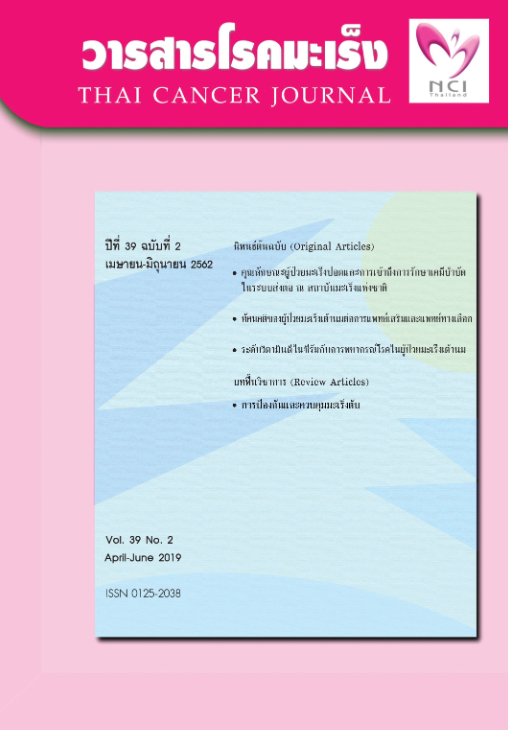Characteristics of Patients with Lung Cancer and Their Access to Chemotherapy in the Referral System of the National Cancer Institute
Keywords:
characteristics, lung cancer, access to chemotherapy, referral systemAbstract
This prospective cross-sectional research study aimed to explore the characteristics of lung cancer patients and their access to chemotherapy in the referral system of the National Cancer Institute. The study samples comprised 80 patients diagnosed with lung cancer and treated using chemotherapy, between May and October 2018. Data were collected from the Institute's medical records and information technology system. The samples were males (60 %), had non-small-cell carcinoma (98.8 %), stage IV (61.3 %), completed the treatment programme (96.2 %), and had access to treatment within 6 weeks (87.5 %). The characteristics of the patients that were predictive of access to chemotherapy within 6 weeks were body mass index (BMI) and co-morbid diseases, which could explain 21 % of variation. The findings indicate that the promotion of a healthy diet and disease control will help lung-cancer patients receive chemotherapy according to treatment-access criteria
References
กองยุทธศาสตร์และแผนงาน สํานักงานปลัดกระทรวงสาธารณสุข. สถิติสาธารณสุข พ.ศ. 2560 (Public Health Statistics A.D.2017). เข้าถึงได้จาก: http://bps.moph. go.th/new_bps/%E0. สืบค้นเมื่อวันที่ 2 มีนาคม 2562.
Imsamran W, Pattatang A, Supattagorn P, Chiawiriyabunya I, Namthaisong K, Wongsena M, et al. Cancer in Thailand Vol. VIII, 2013-2015, Bangkok, Thailand, 2018.
สถาบันมะเร็งแห่งชาติ. รายงานทะเบียนมะเร็งระดับ โรงพยาบาล (Hospital-based cancer registry) 25592560. กรุงเทพฯ: พรทรัพย์การพมิพ์; 2561.
Zappa C, Mousa SA. Non-small cell lung cancer: current treatment and future advances. Transl Lung Cancer Res 2016;5:288-300.
National Cancer Institute. SEER Cancer Statistics Review, 1975-2011. Available from: http://seer. cancer.gov/ csr/1975_2011/. Accessed December 21, 2018.
Suina K, Shukuya T, Koyama R, Asao T, Honma Y, Kato M, et al. Risk factors for serious adverse events due to cytotoxic chemotherapy for advanced nonsmall cell lung cancer. Cancer Treat Res Commun 2016;9:106-10.
Fruh M, De Ruysscher D, Popat S, Crino L, Peters S, Felip E, et al. Small-cell lung cancer (SCLC): ESMO clinical practice guidelines for diagnosis, treatment and follow-up. Ann Oncol 2013;24(Suppl 6):vi99-105.
O'Rourke N, Edwards R. Lung cancer treatment waiting times and tumour growth. Clin Oncol 2000;12:141-4.
Kim JO, Davis F, Butts C, Winget M. Waiting Time Intervals for Non-small Cell Lung Cancer Diagnosis and Treatment in Alberta: Quantification of Intervals and Identification of Risk Factors Associated with Delays. Clin Oncol 2016;28:750-9.
Casal-Mouriño A, Valdésa L, Miguel Barros-Diosb J, Ruano-Ravina A. Lung cancer survival among never smokers. Cancer Lett 2019;451:142-9.
Crvenkova S. Prognostic factors and survival in nonsmall cell lung cancer patients treated with chemoradiotherapy. Maced J Med Sci 2015;3:75-9.
สถาบันมะเร็งแห่งชาติ กรมการแพทย์ กระทรวงสาธารณสุข. นิยามตัวชี้วัด Service plan สาขาโรคมะเร็ง ปี 2561-2565. กรุงเทพฯ; 2562.
Krejcie RV, Morgan DW. Determining Sample Size for Research Activities. Educational and psychological measurement 1970;30:607-10.
ฉลองพล สารทอง, หัชชา ศรีปลั่ง, อนัฆพงษ์ พันธ์ุมณี , พอใจ พัทธนิตย์ธรรม. แนวโน้มและการคาดการณ์ อุบัติการณ์โรคมะเร็งปอด จังหวัดขอนแก่น. ศรีนครินทร์เวชสาร 2561;33:222-8.
Van der Drift MA, Karim-Kos HE, Siesling S, Groen HJ, Wouters MW, Coebergh JW, et al. Progress in standard of care therapy and modest survival benefits in the treatment of non-small cell lung cancer patients in the Netherlands in the last 20 years. J Thorac Oncol 2012;7:291-8.
Cheng TY, Cramb SM, Baade PD, Youlden DR, Nwogu C, Reid ME. The international epidemiology of lung cancer: latest trends, disparities, and tumor characteristics. J Thorac Oncol 2016;11:1653-71.
Gould MK, Munoz-Plaza CE, Hahn EE, Lee JS, Parry C, Shen E. Comorbidity Profiles and Their Effect on Treatment Selection and Survival among Patients with Lung Cancer. Ann Am Thorac Soc 2017;14:157180.
Zhong J, Zheng Q, Gao E , Dong Z , Zhao J , An T, et al. Influence of body mass index on the therapeutic efficacy of gemcitabine plus cisplatin and overall survival in lung squamous cell carcinoma. Thoracic Cancer 2018;9:291-97.
Dahlberg SE, Schiller JH, Bonomi PB, Sandler AB, Brahmer JR, Ramalingam SS, et al. Body Mass Index and its Association with Clinical Outcomes for Advanced Non-Small Cell Lung Cancer Patients Enrolled on Eastern Cooperative Oncology Group Clinical Trials. J Thorac Oncol 2013;8:1121-7.
Wang W, Dou S, Dong W, Xie M, Cui L, Zheng C, et al. Impact of COPD on prognosis of lung cancer: from a perspective on disease heterogeneity. Int J Chron Obstruct Pulmon Dis 2018;13:3767-76.
Cheng TY, Cramb SM, Baade PD, Youlden DR, Nwogu C, Reid ME. The international epidemiology of Lung cancer: latest trends, disparities, and tumor characteristics. J Thorac Oncol 2016;11:1653-71.
Grose D, Morrison DS, Devereux G, Jones R, Sharma D, Selby C, et al. The impact of comorbidity upon determinants of outcome in patients with lung cancer. Lung Cancer 2015;87:186-92.
Dutkowska AE, Antczak A. Comorbidities in lung cancer. Pneumonol Alergol Pol 2016;84:186-92.
Kiss N, Isenring E, Gough K, Krishnasamy M. The prevalence of weight loss during (chemo) radiotherapy treatment for lung cancer and associated patient- and treatment-related factors. Clin Nutr 2014;33:1074-80.
Denton E, Conron M. Improving outcomes in lung cancer: the value of the multidisciplinary health care team. J Multidiscip Healthc 2016;30:137-44.
Reinmuth N, Stumpf A, Stumpf P, Muley T, Kobinger S, Hoffmann H, et al. Characteristics and outcome of patients with second primary lung cancer. Eur Respir J 2013;42:1668-76.
Downloads
Published
Issue
Section
License
บทความทีตีพิมพ์ในวารสารโรคมะเร็งนี้ถือว่าเป็นลิขสิทธิ์ของมูลนิธิสถาบันมะเร็งแห่งชาติ และผลงานวิชาการหรือวิจัยของคณะผู้เขียน ไม่ใช่ความคิดเห็นของบรรณาธิการหรือผู้จัดทํา







